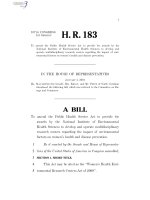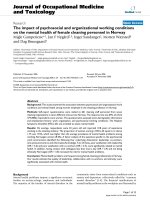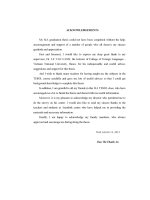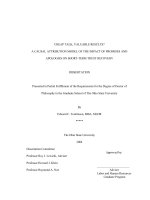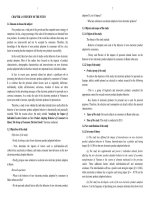The Impact of Repetition and Recycling on Grade 11 Students’ Vocabulary Retention in Long Hai – Phuoc Tinh High School
Bạn đang xem bản rút gọn của tài liệu. Xem và tải ngay bản đầy đủ của tài liệu tại đây (209.52 KB, 6 trang )
The Impact of Repetition and Recycling on
Grade 11 Students‟ Vocabulary Retention in
Long Hai – Phuoc Tinh High School
Phùng Thị Lam
Trường Đại học Ngoại ngữ
Luận văn ThS. Chuyên ngành: English Teaching Methodology; Mã số: 60 14 10
Người hướng dẫn: DO BA QUY, MEd
Năm bảo vệ: 2011
Abstract: Recently, vocabulary has been a prominent concern of many applied linguistic
theorists and researchers in the field of teaching and learning English. When it comes to
studying vocabulary, the greatest challenge is likely retaining the words. Researchers and
teachers now have been drawn to the concern of how to make students enhance
vocabulary retention for communicative value. This minor thesis investigates the impact
of application a wide range of repetitive and recycling-focused activities on 11th grade
students‟ retention in Long Hai – Phuoc Tinh high school. This study was conducted by
quasi-experimental method with 84 participants in the two randomly assigned groups.
The experiment lasted for 6 weeks, during which the students were led through the
reading, speaking, listening, writing and language focus in a normal way. The students in
the experimental group, however, were involved in a variety of additionally cooperative
activities in lessons while there no vocabulary focused activities were employed in the
control group. The data were collected by means of T-test, questionnaires and
observation. The results showed that the repetition and recycling worked on the
experimental group and the experimental group also gave positive feedback on the
treatment. For better application, however, more attention should be paid to the class size,
students‟ level of proficiency and their preferred techniques of memorizing words. In
addition, the study suggests pedagogical implications and recommendations for further
studies.
Keywords: Tiếng Anh; Từ vựng; Phương pháp giảng dạy
Content
PART A – INTRODUCTION
1. Rationale
Vocabulary is central to language and is of great significance to language students. Words
are “the building blocks of a language since they label objects, actions, ideas without which
people cannot convey the intended meaning”(Lotfi Ghazal). Given its importance to learning,
vocabulary has been a prominent concern of many theorists and researchers in the field.
Accordingly, numerous types of approaches, techniques, exercises and practice have been
introduced into the field to teach vocabulary (Hatch & Brown, 1995).
When it comes to studying vocabulary, however, the greatest challenge is likely retaining the
words. Researchers and teachers now have been drawn to the concern of how to make students
enhance vocabulary retention for communicative value. Studies have shown that practising
things makes us better in learning a language and develops automaticity. In other words,
language learning proceeds gradually through repeated exposure and practice. The course book
English 11 (published by Educational Press), however, does not deal with it sufficiently.
Being an EFL teacher in a high school in Ba Ria – Vung Tau, I recognize the fact that many
students now suffer from considerable difficulties in retaining previously encountered English
words. They struggle to maintain retention. But not many of them are capable of it. This matter
of fact leads to their poor production both in speaking and writing. Furthermore, there is another
fact that we have to face, that is most of students now have active social lives, families, studies
with lots of compulsory subjects, sports and generally other things which make them really
occupied – not just one of English. That leaves me with the responsibility to do revision lessons,
review vocabulary and make sure they know what have been taught. The idea of a study on how
to enrich students‟ vocabulary retention of mine emerges in that situation.
Currently working with 11
th
graders in addition to continual working with them in four recent
years makes me designate them. A wide range of designed activities were carried out (mostly at
the beginning of the classes) when teaching two classes named 11A3 and 11A5 at Long Hai –
Phuoc tinh high school. And the results supported my hypothesis that teachers can create
repetitive and recycling-focused activities to help students improve their vocabulary retention.
2. Aims of the study
The study aims at proving that repetitive and recycling focused activities can help 11
th
grade
students to retain words better. These students are non-English major ones and have three classes
of English a week. There exists a fact that they cannot retrieve the words which they have learnt
in previous lessons for communication when needed. In other words, they soon forget words they
have just acquired. The main aim of this study therefore is to investigate the impact of repetition
and recycling on vocabulary learning and retention, or to put it differently, the extent to which
short tailored activities helps to retain vocabulary for the students at Long Hai – Phuoc Tinh
High school and provide some pedagogical implications.
3. Scope of the study
There are enormous activities as tools of enhancing vocabulary retention available on the
internet that you can approach with a mouse click. Most of them are easy to be applied and
tested. In the current study, I set the limit of investigating possibly – applied activities that can be
carried out at beginning or in the middle of 45-minute periods in such large-sized classes at Long
Hai – Phuoc Tinh High school, vung Tau. The activities were related to first three units (which
equal to 18 lessons) of the course book English 11 introduced by Educational Press only because
with the timeframe of 6 weeks it is supposed to be infeasible to conduct a research study on a
larger scale which can produce very convincing results.
4. Research hypotheses and questions
In order to achieve the above purposes, the study was designed to test the following hypotheses:
Null hypothesis: The students who take part in the experiment get the same
result measured in the post-test and have the same improvement in their vocabulary retention as
those who do not.
Alternative hypothesis: Students who frequently deal with repetitive and
recycling activities will perform better overall in the post test and have some improvement in
their skills in comparison with those who do not have extra vocabulary-oriented activities.
So as to draw the conclusion on the hypothesis, the study is to get the answers to the
following questions: (1) To what extent do EFL teachers encourage repetition and recycling
vocabulary among their students? (2) What is the effectiveness of using repetitive and recycling
focused activities on enhancing 11
th
- graders’ vocabulary retention? (3) What are the students’
attitudes towards using activities in teaching and learning vocabulary?
5. Method of the study
The first method applied in this study is a quasi-experimental design which involves the three
components of experiments according to Selinger and Shohamy (1989): the population (the 11
th
grade students at Long Hai – Phuoc Tinh high school, Ba ria Vung tau), the treatment (repetitive
and recycling focused activities), and the measurement of the treatment (T-test).
In addition, questionnaires were delivered to teachers who currently teach other 11
th
grades to investigate how they have dealt with vocabulary teaching, especially the ways they
encourage repetition and recycling vocabulary among students. Another questionnaire was
delivered to the subjects before treatment to get to know their own strategies of memorizing
vocabulary. The third questionnaire was delivered to the subjects after treatment as a supporting
tool to obtain students‟ attitude towards the technique applied. What is more, observation was
also employed during the teaching time to recognize the participation of students in the control
group and the experimental group.
6. Organization of the study
This thesis is organized around three parts:
Part A is the introduction which presents the rationale for the research topic, aims of study, scope
of study, research hypotheses and questions, and method of the study.
Part B is the development which consists of three chapters. Chapter one reviews scholarly
theoretical background to teaching and learning vocabulary in a second language including
factors which affect vocabulary acquisition process. This chapter also reviews some meaningful
activities which are initiated by different researchers. Chapter two deals with the methodology of
this research in terms of the setting of the study, sampling participants, instruments and
procedure of data collection. Chapter three devotes to the account of the study in terms of data
analysis and findings interpreted from the results of the T-test and questionnaires.
Part C is the conclusion which discusses the major findings and limitations of the research, then
suggests teaching implications and proposes some suggestions for further research.
REFERENCES
- Ahmed, M.O. (1989). “Vocabulary learning strategies.” In P. Meara (Ed.) Beyond
Words.London: CILT, pp. 3-14.
- Aitchison, J. (1987). Words in the Mind: An Introduction to the Mental Lexicon.
- Allen V.F. (1983). Techniques in Teaching Vocabulary. Oxford: Oxford University Press.
- Anderson, J. R. (2000). Cognitive psychology and its implication. New York: Worth.
- Baker, Simmons, & Kame'enui. (1997). Vocabulary acquisition: Research bases. In
Simmons, D. C. & Kame'enui, E. J. (Eds.), What reading research tells us about children
with diverse learning needs: Bases and basics. Mahwah, NJ: Erlbaum.
- Baumann, J. F., Kame„enui. (2003). Research on vocabulary instruction: Handbook on
research on teaching the English language arts (2nd ed., pp. 752–785). Mahwah, NJ:
Erlbaum
- Beck, I. L., McKeown, M. G., & McCaslin, E. S. (1983). “All contexts are not created
equal”. Elementary School Journal, 83, 177–181.
- Blachowicz, C., & Fisher, P. (2000). “Vocabulary instruction”, Handbook of
readingresearch (Vol. 3, pp. 503–523). Mahwah, NJ: Erlbaum.
- Cameron, K. (2001). (Ed.). CALL - The challenge of change. Exeter: Elm Bank
Publications
- Carter, R. (2000) Vocabulary: Applied Linguistic Perspectives (2
nd
edition) London:
Collins.
- Carter, R. 1998. Vocabulary – Applied Linguistic Perspective - Routlegde.
- Coady, J and Huckin, T. (eds) Second Language Vocabulary Acquisition. Cambridge:
Cambridge University Press
- Craik, F. and Lockhart, R. - Learner Strategies in Langudge Learning - New York:
Prentice Hall.
- de Cock, S., Granger, S., Leech, G., & McEnery, T. (1998). An automated approach to
the phrasicon of EFL learners. In S. Granger (Ed.), Learner English on computer, (67-
79) London: Longman.
- Ebbinghaus, H. (1885). Memory: A contribution to experimental psychology. Leipzig:
Duncker & Humblot.
- Ellis, N.C. Vocabulary Acquisition: Word Structure, Collocation, Word-class and
Meaning. Cambridge: Cambridge University Press, 1997.
- Felder, R., and Henriques, E. (1995). “Learning and Teaching Styles in Foreign and
Second Language Education”. Foreign Language Annals, 28 (1): 21–31.
- Folse, K. (1999). The effect of written practice activity on second language vocabulary
retention. Unpublished doctoral dissertation, University of South Florida, Tampa.
- Gairns, R. & Redman, S.(1986) Working with words: A Guide to Teaching and Learning
Vocabulary. Cambridge: Cambridge University Press.
- Ghazal, L. “Learning Vocabulary In Efl Contexts Through Vocabulary. Learning
Strategies”, Novitas Royal , Vol: 1(2). pp. 84-91.
- Goodman, D. (1987). The complete HyperCard handbook. New York: Bantam.
- Grynnerup, D. (2011). “Use Me, Re-use Me and Try not to Lose Me - the whys and hows
of recycling language”. International House, Bratislava, Eaquals Conference 2011,
Prague.
- Hatch, E. and Brown, C. (1995). Vocabulary, Semantics and Language Education,
Cambridge: Cambridge University Press.
- Hill, J. (1999) “Collocational competence” English Teaching Professional, Vol.11, pp. 3-
6.
- Hulstijn, J. (1992). Retention of inferred and given word meanings: Experiments in
incidental vocabulary learning. In P Arnaud &: H. Bejoint (Eds.), Vocabulary and Applied
Linguistics (pp. 113-125). London: Macmillan Academic and Professional Limited.
- Jackson, H. and E. Z. Amvela (2007). Words, Meaning and Vocabulary. New York,
Continuum.
- Jackson, H., & Amvela, E. Z. (2007). Words, Meaning and Vocabulary. New York:
Continuum.
- Joe, A. “Vocabulary Learning and Speaking Activities”, ETF.Vol.34 No 1, January -
March 1996 Page 2
- Johnson, Dale D., and P. David Pearson. (1984). Teaching Reading Vocabulary. 2d ed.
New York: Holt, Rinehart and Winston.
- KESKİNÖZ, B. (1994). Acquiring Vocabulary through Self Study. Aston University.
- Lewis, M. (1993) The lexical approach. LTP.
- Lewis, M. (1997) Implementing the lexical approach. LTP.
- Lightbown, P. M & Spada, N. 1999. How Languages are Learned. Oxford University
Press.
- McCathy, M.J. (2000). Captive Audiences. The Discourse of Close Contact service
encounters. In J. Coupland (Ed) Small talks. (pp.84-109). London: Longman.
- Melton, A.W. (1970). “The situation with respect to the spacing of repetition and
memory”. Journal of verbal learning and verbal behaviors. Vol.9, pp.596-606.
- Morgan, B.Q. and Oberdeck, L.M. (1930). Active and passive vocabulary. In E.W.
Bagster-Collins (ed) Studies in Modern Language Teaching 16, New York: 213-221. [2.4]
- N. Schmitt and M. McCarthy (eds), 1997. Vocabulary: Description, Acquisition and
Pedagogy (pp. 199-227). Cambridge University Press.
- Nagy, W. 1997. On the role of context in First and Second-language Vocabulary
Learning. Cambridge: Cambridge University Press.
- Nagy, W. E., & Scott, J. A. (1990). “Word schemas: What do people know about words
they don‟t know?” Cognition & Instruction, 7, 105–127.
- Nation, I.S.P (2001) Learning Vocabulary in Another Language. Cambridge: Cambridge
University Press.
- Nation, I.S.P. (1994) “Review of three books on vocabulary teaching”. System 22, 2: 15-
19.
- Nation, I.S.P. (2005) “Ten best ideas for teaching vocabulary”. The Language Teacher 29,
7: 11-14.
- Nunan, D. (1992). Research Methods in Language Learning. Cambridge: Cambridge
University Press.
- Nunan, D. (1999). Second Language Teaching and Learning. Boston: Heinle & Heinle.
- O‟Malley, J. M., & Charmot, A.U. (1990). Learning Strategies in Second Language
Acquisition. Cambridge: Cambridge University Press.
- Obermeier, A. (2008). A Pilot Study Comparing Vocabulary Retention in Bilingual and
Monolingual Tasks. MA. Thesis. Kyo-kyo University.
- Oxford, R. L. (1990). Language learning strategies: What Every Teacher Should Know.
Boston: Newbury house
- Pollard, L. (2008). Teacher, I Need More Words! Effective Student-Centered Vocabulary
Activities. An Alta Book Center Workshop.
- Rixon, S. 1981. How to use games in language teaching. London: Macmillan Publishers
Ltd.
- Schmitt, N. (2000). Vocabulary in Language Teaching. Cambridge, New York,
Cambridge University Press.
- Scrivener, J. (1994) Learning teaching. Heinemann.
- Selinger, H.W., Shohamy, E. (1989). Second Language Research Methods. Oxford: Oxford
University Press.
- Spada, N. & Lightbown, P. M. “Second Language Acquisition” in (ed.) N. Schmitt, An
introduction to applied linguistics. London: Arnold
- Steven A. Stahl and Sandra J. vancil (1986). “ Discussion is what makes semantic maps
work in vocabulary instruction”. The reading teacher , Vol 40, October 1986
- Tessa Woodward, (2001). Planing Lessons and Courses. Cambridge: Cambridge
University Press.
- Thompson, C. P., Wenger, S. K., & Bartling, C. A. (1978). “How recall facilitates
subsequent recall: A reappraisal”. Journal of Experimental Psychology: Human Learning
and Memory, Vol.4, pp.210–221.
- Thornbury, S. (2002). How to Teach Vocabulary. Essex, Pearson Education Limited.
- Uberman, A. (1998). “The Use of Games For Vocabulary Presentation and Revision”.
Forum Vol. 36 No 1, January - March 1998. P.20.
- Van, Hoang Van et al. (2002). Tieng Anh 11: the textbook and guidebook. Education
Press.
- Wenden, A. and Rubin, J. (1987). The learning strategies of ESL students. Chamot, A.U.
- Wiersma, W. (1995). Research methods in education: An introduction (Sixth edition).
Boston: Allyn and Bacon.
- Yule, G. (2006). The Study of Language (3rd ed.). Cambridge, New York: Cambridge
University Press.
